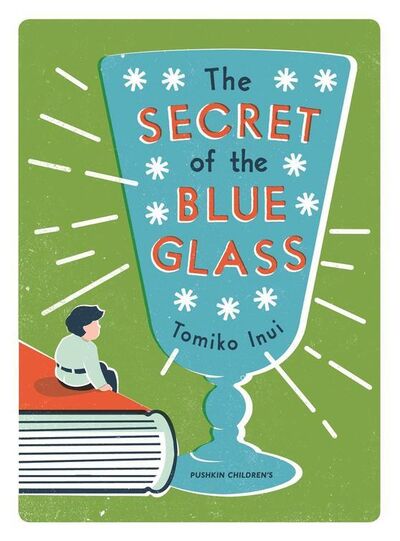Hand in Hand
The Secret of the Blue Glass
By Tomiko Inui (Translated by Ginny Tapley Takemori)

6 Nov, 2024
Tomiko Inui’s 1967 The Secret of the Blue Glass is a historical fantasy children’s book. First published in Japanese as Kokage No Ie No Kobitotachi (Yuri and the Little People), the 2017 English translation is by Ginny Tapley Takemori.
English teacher Miss MacLachlan returns to England having spent twenty years teaching Japanese children. Before she leaves, Miss MacLachlan bequeaths a very special responsibility to her young student Tatsuo Moriyama. Tatsuo and his family are now the guardians of two Little People, Balbo and Fern Ashe.
Balbo and Fern Ashe are only a hand’s length tall. They and their eventual children, Iris and Robin, live in a library sanctuary Tatsuo made for them. Young Tatsuo is the one who gives the Little People their daily glass of milk. When he marries, the responsibility passes down to the Moriyama children, daughter Yuri in particular.
Pacific-War-era Japan is not the Japan with which Miss MacLachlan fell in love in the 1890s. This Japan is militaristic, imperialist, and intolerant of dissent. Tatsuo discovers this the hard way. The Kempeitai descend on the Moriyama household, confiscate banned books, and drag Tatsuo off to prison as a traitor.
Each of the Moriyamas reacts in their own way. Tatsuo’s wife Toko does her best to provide for her children, Tetsu, Yuri, and Shin, while supporting her husband in prison. Tetsu is as dissatisfied with the war as his father. Sickly Yuri focuses on feeding the Little People. Shin becomes a raving fanatic, critical of his relatives’ unpatriotic ways.
The Moriyama household survived the Great Kanto Earthquake. It’s clear that it may not be so lucky once American bombers can reach Japan. Accordingly, Toko makes the painful decision to send ailing Yuri off to the country for the girl’s safety. Yuri takes the Little People with her.
Rural life is hard. Once the locals discover that Yuri’s father is in jail, and why, she becomes the town pariah. While life there is better than life in Tokyo, which has largely been burned to the ground, food is in increasingly short supply. Can Yuri survive? Can she somehow cadge enough milk to keep the Little People fed? What will the consequences be if she does not?
~oOo~
Yuri is risking her health by giving milk to the Little People (milk that she could use to stave off malnutrition). We learn that Robin and Iris can fend for themselves when necessary, so why should they batten on Yuri? I don’t think they come off well in this book.
Before Yuri is born, Tatsuo’s sister Yukari is introduced as a possible protector of the Little People, a move that seems to indicate she will be one of the book’s protagonists. She almost immediately languishes and dies, leaving the situation with the Little People virtually unchanged. This interlude might seem pointless but it serves to establish an important point. Children, even very adorable children, do not have plot immunity.
This is a reality of which the children are well aware. Shin would prefer that his weakling, unpatriotic sister die and relieve the state of her care. Tetsu is well aware of what is waiting for him as soon as he is old enough for military service. As one of his schoolmates puts it:
Our life as students is just a stay of execution — just until we go to war and die.
The pacing is rather odd, as is the plotting. Aside from choosing to protect the Little People, Yuri does not have much control over events. Not surprising, as she is a child in a society that prioritizes obedience. The novel stops rather than ending. The Little People seem a bit superfluous to the plot. Some readers may find the book puzzling and frustrating, when they are not being horrified.
Secret does paint a vivid picture of child’s life in Japan during the Second World War. The author’s purpose may have been to underline for Japanese children just how awful WWII was for Japanese, in a way that did not allow the blame to be shifted onto the Allies. Which, as I think about it, is probably a valuable lesson worth repeating from time to time.
Rather dark for children’s fare, although of course a real thigh-slapper compared to other Japanese children’s war stories such as Barefoot Gen and Grave of the Fireflies.
The Secret of the Blue Glass is available here (Amazon US), here (Amazon Canada), here (Amazon UK), here (Barnes & Noble), and here (Kobo).
I did not find The Secret of the Blue Glass at Apple Books or Words Worth Books, and not only did I not find the novel at Chapters-Indigo, when I searched on the author’s name, I was offered an assortment of what look like soft-core porn manga. I wonder if that’s because one of the characters is named “Yuri”?
